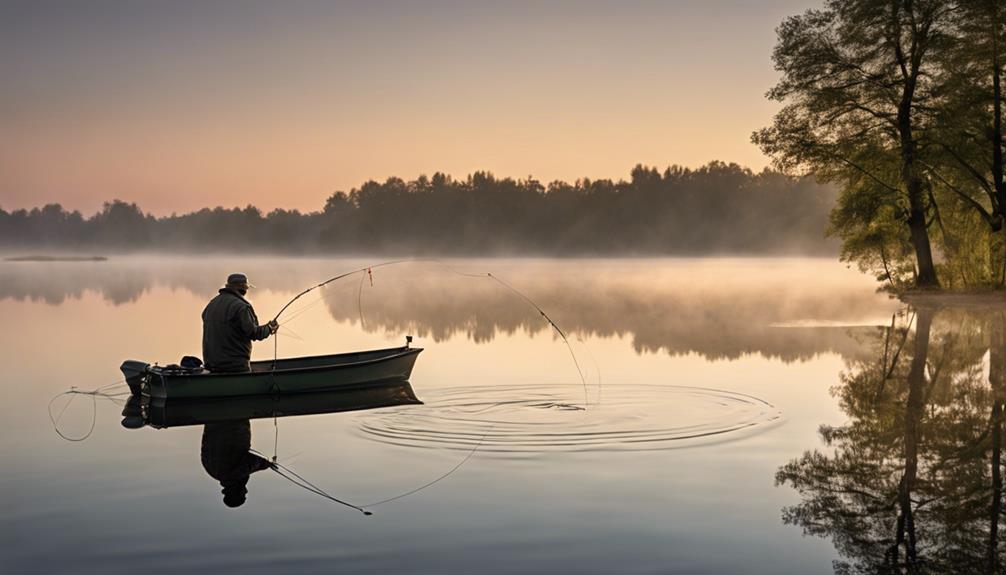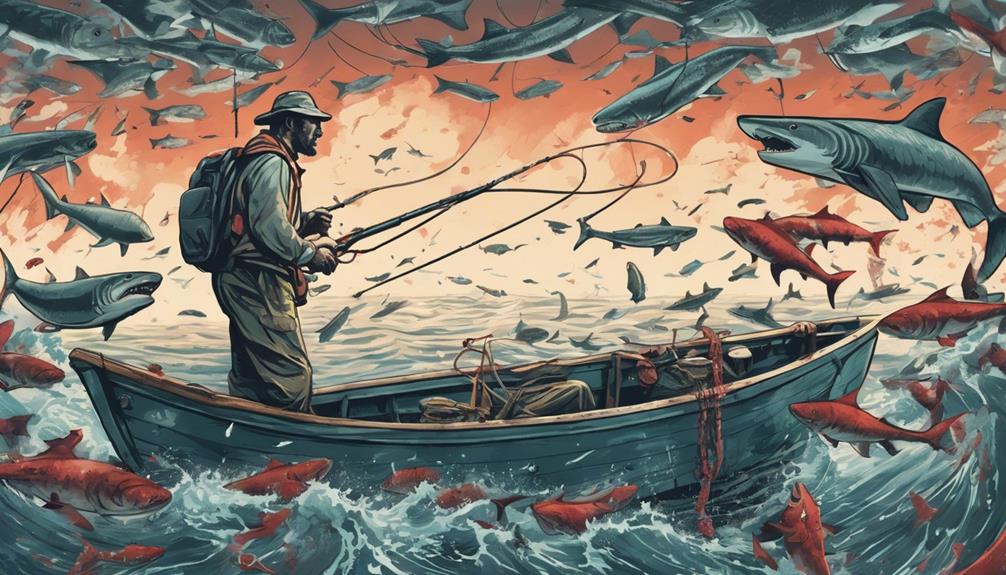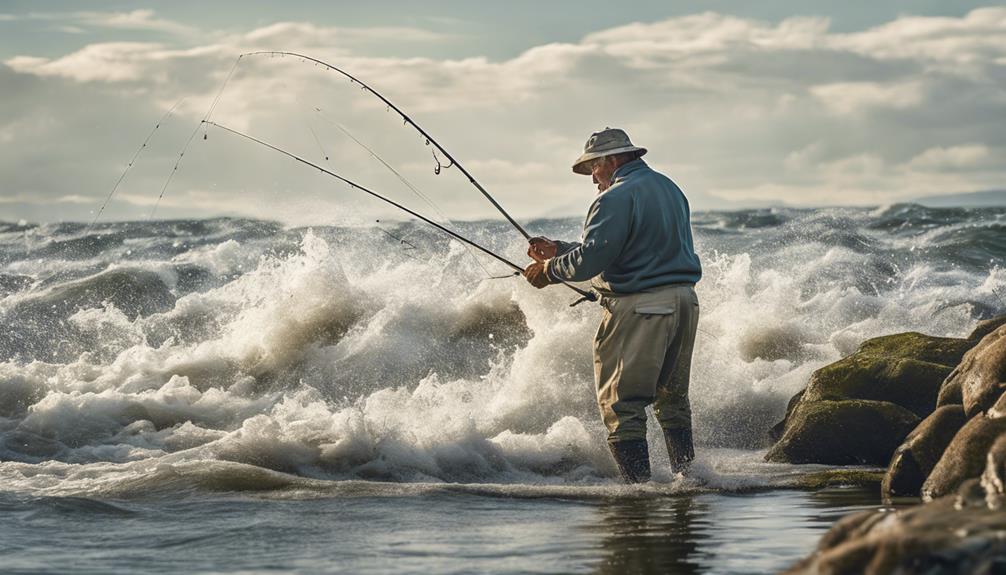When it comes to successful salmon fishing, having the right techniques is like having a key to unlock a hidden treasure. From choosing the perfect spot to understanding the behavior of these elusive fish, each step plays a crucial role in your angling journey.
But what are the six best techniques that will elevate your salmon fishing game and increase your chances of a bountiful catch? Let's explore these strategies and uncover the secrets to reeling in that prized salmon you've been dreaming of.
Identifying the Best Salmon Spots
To catch more salmon, scout along riverbanks or research local fishing reports for the best spots. Locating hotspots is crucial for a successful salmon fishing trip. Understanding the seasonal migrations and feeding habits of salmon can greatly increase your chances of landing a big catch.
When trying to identify the best salmon spots, it's essential to study patterns in their behavior. Salmon tend to follow specific routes during their seasonal migrations. By researching these patterns, you can pinpoint the most productive areas along the river where salmon are likely to pass through.
Another key factor in locating hotspots is understanding the feeding habits of salmon. These fish are often attracted to areas with abundant food sources. Look for spots where there's a concentration of baitfish or where the water conditions are favorable for the salmon to feed.
Local fishing reports can also be a valuable resource in identifying the best salmon spots. These reports often provide up-to-date information on where salmon have been recently caught and the techniques that have been successful. By staying informed through these reports, you can increase your chances of finding the perfect spot to reel in that prized salmon.
Understanding Salmon Behavior
Scout along riverbanks and research local fishing reports to pinpoint the most productive areas where salmon are likely to pass through, as understanding their behavior is key to successful fishing. Salmon exhibit distinct behaviors influenced by their life cycle stages. For instance, knowing their spawning patterns is crucial. Salmon typically return to the same rivers or streams where they were born to spawn. During the spawning season, they become more aggressive towards bait, making it an opportune time for fishing.
Understanding salmon feeding habits is equally important. These fish are known to feed actively before entering their spawning grounds, making them more likely to bite baited hooks. Researching their migration routes can give you an edge. Salmon often follow specific paths during their migration, so positioning yourself strategically along these routes can increase your chances of a successful catch.
Additionally, being aware of predator avoidance techniques can help in predicting salmon behavior. Salmon are prey to various predators like bears and birds, so they tend to avoid areas where they feel threatened. Knowing where salmon might seek shelter can guide you to the right fishing spots. By comprehending these aspects of salmon behavior, you can enhance your fishing experience and improve your catch rate significantly.
Selecting the Right Gear
When gearing up for successful salmon fishing, ensure you have the right equipment to match the specific behavior and habits of these elusive fish. Proper gear maintenance and storage are crucial to ensure your equipment is in top condition for your fishing trips. Make sure to clean your gear after each use, checking for any signs of wear and tear. Store your gear in a cool, dry place to prevent rust and deterioration.
Customizing and upgrading your gear can greatly improve your chances of a successful catch. Consider upgrading your fishing rod to a model specifically designed for salmon fishing, with the right balance of strength and flexibility. Upgrading your reel to one with a smooth drag system can help you reel in those big salmon with ease. Additionally, customizing your lures to mimic the salmon's natural prey can increase your chances of attracting bites.
Investing in quality gear that's well-maintained and customized to suit salmon fishing can make a significant difference in your fishing success. By taking the time to care for your equipment and make necessary upgrades, you'll be better prepared to tackle the challenges of salmon fishing and increase your chances of a rewarding catch.
Mastering Different Fishing Methods
Mastering different fishing methods requires understanding the unique techniques and strategies tailored to the behavior of salmon. When it comes to line control and rod movement, it's crucial to adjust your approach based on the specific type of salmon you're targeting. For instance, when fishing for Chinook salmon in deeper waters, using downriggers to control the depth of your line can be highly effective. On the other hand, when pursuing Coho salmon in shallower areas, utilizing a lighter setup and focusing on precise rod movements to mimic baitfish can yield better results.
Water depth and current speed play a significant role in determining the success of your fishing expedition. Before casting your line, take the time to assess these factors and adapt your technique accordingly. For example, in fast-moving waters where salmon tend to swim closer to the surface, using lures that stay near the top and adjusting your rod movements to create enticing movements can attract more bites. Conversely, in deeper or slower-moving waters, employing sinking baits and varying your retrieval speed can help you reach the desired depth where salmon are likely to be feeding.
Perfecting Your Casting Techniques
To enhance your success in salmon fishing, refining your casting techniques is essential for accurately presenting your bait to the target area. Improving accuracy and increasing distance are crucial aspects to focus on when perfecting your casting techniques.
When aiming for accuracy, concentrate on your arm motion and release point. Smoothly transition your rod from the backcast to the forward cast, ensuring a straight line trajectory towards your desired spot. By practicing this motion, you can consistently place your bait where the salmon are likely to be feeding. Additionally, pay attention to your wrist movement, as a controlled flick of the wrist at the right moment can greatly improve your accuracy.
To increase the distance of your cast, proper timing and power are key. Utilize the strength of both your arm and wrist to generate momentum. As you bring the rod forward, accelerate smoothly and release at the optimal point to achieve maximum distance. Remember that practice makes perfect, so regularly practicing your casting techniques will help you refine your skills and cast further with precision.
Fine-Tuning Your Lure Presentation
Refining your lure presentation is crucial for enticing salmon to bite and increasing your chances of a successful catch. To fine-tune your approach, consider the following key aspects:
- Lure Selection: Choose the right lure based on the water conditions, time of day, and the specific type of salmon you're targeting. Experiment with different colors, sizes, and types of lures to see what works best.
- Presentation: Pay attention to how you present your lure to the salmon. Make sure your lure mimics the movement of natural prey to appear more enticing. Adjust your retrieval speed and depth based on the behavior of the salmon.
- Reeling Techniques: Practice varying your reeling speed and incorporating pauses to create a more realistic bait movement. This can trigger a salmon's predatory instincts and lead to more bites.
- Bait Movement: Focus on creating a natural and erratic movement with your lure. Jerk the rod occasionally to simulate injured prey or use a twitching motion to make the lure appear alive and appealing to salmon.
- Observation: Keep a close eye on how salmon react to your presentation. If you notice a pattern in their behavior, adjust your techniques accordingly to improve your chances of a successful catch.
Practicing Patience and Persistence

When it comes to successful salmon fishing, mastering the art of patience and persistence is key. Time management plays a crucial role in your fishing expedition. Arriving at the right time of day when salmon are most active increases your chances of a successful catch. Additionally, allocating ample time for your fishing trip allows you to patiently wait for the perfect moment when the salmon are biting.
To enhance your patience and persistence, consider incorporating relaxation techniques into your fishing routine. Deep breathing exercises or simply taking in the serene surroundings can help you stay calm and focused. Maintaining a positive mindset is equally important. Visualize yourself reeling in a prized salmon and stay optimistic even if the bites are slow.
As you navigate the waters in search of salmon, remember that mental focus is key. Stay attentive to your surroundings, watch for signs of fish activity, and be ready to adapt your strategy as needed. By honing your mental acuity and maintaining a positive outlook, you set yourself up for a rewarding fishing experience. So, embrace patience, manage your time wisely, and persist with determination – the salmon you're after may just be a cast away.
Adapting to Changing Conditions
Embracing flexibility is crucial when adapting to changing conditions while salmon fishing. Being able to adjust your strategy on the fly will significantly improve your chances of a successful catch. Here are some key points to consider:
- Weather adjustments: Keep an eye on the weather forecast and be prepared to alter your plans accordingly. Salmon behavior can change with different weather patterns, so adapting to these changes can make a big difference in your fishing success.
- Tidal shifts: Understanding how tidal shifts can impact salmon movement is essential. Fish tend to be more active during certain tidal phases, so being aware of these shifts can help you position yourself in the right spot for a good catch.
- Water clarity: Pay attention to the clarity of the water. Salmon may react differently to bait and lures based on how clear or murky the water is. Adjust your fishing techniques based on water clarity to maximize your chances of hooking a salmon.
- Seasonal patterns: Different seasons can bring about changes in salmon behavior. Whether it's spawning season or feeding season, knowing the seasonal patterns of salmon can help you adapt your fishing tactics accordingly.
- Stay alert and be willing to experiment: Don't be afraid to try new techniques or switch things up if your current approach isn't yielding results. Stay alert to changes in conditions and be open to experimenting with different methods to find what works best.
Frequently Asked Questions
How Can I Properly Handle and Release Salmon to Ensure Their Survival After Catching Them?
When handling and releasing salmon, it's crucial to be gentle and mindful. Proper handling techniques ensure the salmon's survival and conservation.
To release them safely, support their body in the water until they regain strength. Avoid using a net or touching their gills.
Are There Any Specific Regulations or Restrictions I Need to Be Aware of When Salmon Fishing in Certain Areas?
When salmon fishing in certain areas, be aware of specific regulations. These may include license requirements, conservation measures, local regulations, and catch limits. Ensure you follow these rules to protect the salmon population and maintain sustainable fishing practices.
Always check with local authorities or fishery departments to stay informed about any restrictions or guidelines in place to help preserve the salmon population for future generations.
What Are Some Common Mistakes That Beginner Salmon Fishermen Make and How Can They Be Avoided?
When starting out, beginner salmon fishermen commonly fall into common pitfalls like using the wrong gear or not understanding the behavior of the fish. To avoid these mistakes, it's essential to research the proper equipment and techniques needed.
Additionally, gaining knowledge about salmon behavior and migration patterns can greatly increase your chances of success. By taking the time to learn and prepare adequately, you can prevent these errors and have a more fruitful fishing experience.
How Can I Effectively Clean and Prepare the Salmon I Catch for Cooking?
When you catch a salmon, the first step is to clean and prepare the salmon fillet properly. Start by removing scales, gutting the fish, and removing the head. Rinse the fillet under cold water to remove any remaining scales or debris.
To cook the salmon fillet, you can try grilling, baking, or pan-searing it. Each method offers a unique flavor profile, so experiment to find your favorite cooking style.
Are There Any Advanced Techniques or Strategies That Experienced Salmon Fishermen Use to Increase Their Success Rates?
When fishing for salmon, experienced anglers focus on reel control for smooth casting and accuracy. They pay attention to bait presentation to entice the fish and maintain proper line tension for a good hook set.
Conclusion
Now that you've learned the best techniques for successful salmon fishing, it's time to put your skills to the test.
Remember to identify the best spots, understand salmon behavior, select the right gear, master different fishing methods, perfect your casting techniques, and fine-tune your lure presentation.
With patience, persistence, and the ability to adapt to changing conditions, you'll be reeling in those prized salmon in no time.
Happy fishing!



